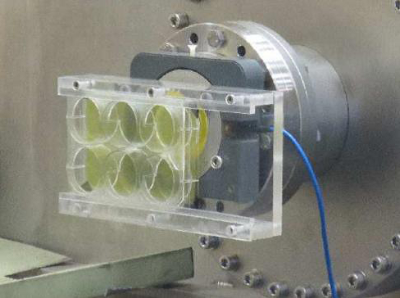Response of EBT3 films to low energy protons in the Bragg peak region
One of the major advantages of proton or ion beams, applied in cancer treatment, is their excellent depth-dose profile exhibiting a low dose in the entrance channel and a distinct dose maximum (Bragg peak) near the end of range in tissue. In the region of the Bragg peak, where the protons or ions are almost stopped, experimental studies with low-energy particle beams and thin biological samples may contribute valuable information on the biological effectiveness in the stopping region. Such experiments, however, require beam optimization and special dosimetry techniques for determining the absolute dose and dose homogeneity for very thin biological samples.
At the National Centre of Accelerators (CNA) in Seville, one of the beam lines at the 3 MV Tandem Accelerator was equipped with a scattering device, a special parallel-plate ionization chamber with very thin electrode foils and target holders for cell cultures. In this context, Cristina Battaglia and co-workers carried out the study for the calibration in absolute dose of EBT3 films for proton energies in the region of the Bragg peak, where the linear energy transfer (LET) effects are more significant for radiobiology studies, as well as the response of the EBT3 films for different proton energy values.
To irradiate the films in the Bragg peak region, the energy of the beam was degraded passively, by irradiating the films interposing some mylar foils to move the Bragg peak inside the active layer of the film. The results obtained for the beam degraded in mylar foils were compared with the dose calculated by means of the measurement of the beam fluence with an ionization chamber, showing effects of saturation in the films and the need to establish a new protocol for film dosimetry in this region.
This work has been submitted for publication in Physical Review Accelerators and Beams.

Experimental setup for the irradiation of radiochromic films. The picture shows the kapton window, the ionization chamber and the holder for the film mounted together at the end of the beam line.